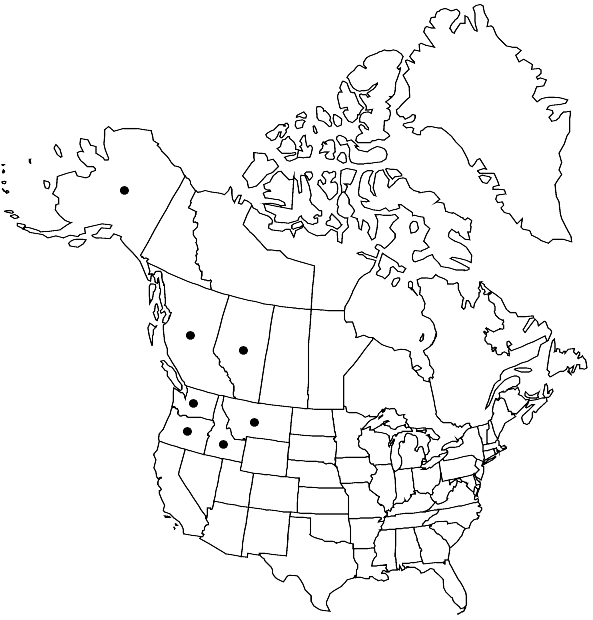Dicranum pallidisetum
Bryologist 68: 446. 1965,.
Plants in loose tufts, dark green to yellowish green, dull to glossy. Stems 1–6 cm, tomentose with white or reddish-brown rhizoids. Leaves often secund, straight or nearly so, often crisped when dry, smooth, 4–8 × 0.5–1 mm, lanceolate, acute, tubulose to apex; margins entire below, serrulate ot serrate near apex; laminae 1-stratose or sometimes 2-stratose on distal margins; costa excurrent, 1/5–1/3 the width of the leaves at base, abaxially papillose or toothed from leaf middle to apex, abaxial ridges absent, with a row of guide cells, stereid bands often present and well-developed in proximal part of leaf, absent in distal 1/4–1/3 of leaf, cells above and below guide cells large and thin-walled; cell-walls between lamina cells not or slightly bulging; leaf cells smooth or often strongly papillose in distal half of leaf; alar cells 2-stratose, differentiated, often extending to costa, abaxial ridges absent; proximal laminal cells linear to rectangular, with or without pits, (26–) 58–95 (–130) × (10–) 12–14 (–16) µm; distal laminal cells quadrate, rounded, irregularly angled or short-rectangular, not pitted, (10–) 15–26 (–38) × (8–) 9–11 (–12) µm. Sexual condition dioicous; male plants as large as female plants; interior perichaetial leaves abruptly short-acuminate, convolute-sheathing. Seta 1–2.5 cm, solitary or sometimes 2, rarely 3, per perichaetium, yellow, rarely reddish yellow or brown with age. Capsule 1.5–3.5 mm, arcuate, inclined, often with a small struma, strongly furrowed when dry, contracted below mouth, yellow or yellowish-brown, rarely reddish yellow or brown with age; operculum 1.5–2.5 mm. Spores 14–20 µm.
Phenology: Capsules mature in summer.
Habitat: Humus or soil over rock, rarely rotting logs or decayed wood
Elevation: 500-2000 m
Distribution

Alta., B.C., Alaska, Idaho, Mont., Oreg., Wash.
Discussion
Dicranum pallidisetum has often been confused with D. fuscescens, being considered a form of it for many years (R. R. Ireland 1966). Unlike that species, which often occurs at low altitudes below 800 m, D. pallidisetum occurs predominately at high elevations, 800–2000 m, rarely being found as low as 500 m. It is distinguished from D. fuscescens by its tubulose leaves, usually 1-stratose or rarely 2-stratose on the margins, by its costa cross section that shows no stereid bands in the distal 1/3 of the leaf, and by its yellow or yellow-brown capsules that are sometimes 2–3 per perichaetium. In contrast, D. fuscescens has leaves keeled above, usually 2-stratose on both margins, rarely 1-stratose on one margin, stereid bands present throughout the leaf and dark brown to reddish brown capsules that are solitary or rarely 2 per perichaetium.
Selected References
None.